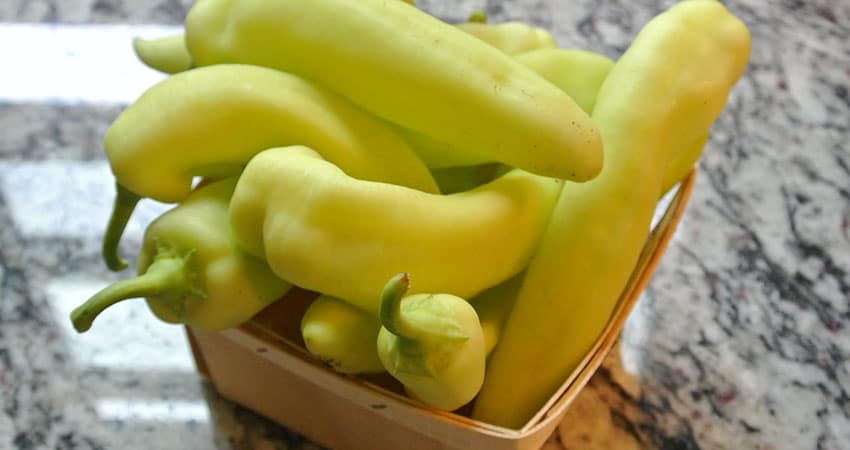When to Pick Banana Peppers

Named for their reflective shape of the sweet tropical goodness of bananas, banana peppers can be contradictive of their namesake, since these cousins of the chili pepper can be a tangy and sweet, yet sometimes spicier, treat for the senses. They have thick waxy outer skins and few seeds. Their color is often yellow, but can be orange or red as well.
The Beauty of Banana Peppers
These slender delicate peppers are not only sweet, tangy, crisp, and delightful, but they are excellent sources of valuable nutrients, full of health benefits. Adding them to your regular menu will help to improve blood circulation and reduce blood pressure, as well as adding in digestion. These beauties are low in fat and low in calories (only nine calories in a pepper about 4” long). However, they are crammed packed full of vitamin C (containing 200% of the recommended daily value as defined by the US Department of Agriculture). They also contain vitamin B6, vitamin K, vitamin A, manganese, potassium, iron, calcium, a little fiber, and a little protein.

Varieties
Banana peppers are generally sweet in nature but a slightly more spicy variety does exist. This mildly spicy pepper is generally around 6” in length, has a medium hot bite, and grows hotter the longer it is allowed to ripen on the plant, turning crimson red. You can grow both varieties in the same garden; however, they will cross germinate, so it is advised that you should plant each variety with significant distance between the plants.
How to Grow a Great Pepper
Banana peppers require full sun but not direct sun, for the scorch can quickly damage the leaves of the plant and develop a form of decay called sunscald. These delicate plants require moist, adequate watering but good drainage, lest they develop root rot. Always water from the soil rather than overhead to reduce disease and infestation. They are prone to insects and disease. Watch for signs of injury and respond quickly. Removal of any visible insects and the application of a mild soapy water spray to the entire plant, from leaves to soil will often be enough to remove the parasites. Cutworms seek out the tender shoots of seedlings, so a regular inspection is beneficial. Aphids, tiny white looking bugs, like to group in clusters on the underside of leaves. When present, the excretions cause leaves to grow distorted and they wilt. Armyworms and fruit worms prefer the developing fruit pods but sometimes eat away at foliage too. Flea beetles target immature plants and are identifiable by the small holes left in the leaves. Whiteflies are exceptionally damaging since they fly from plant to plant, spreading viruses, and damaging leaves. If you notice any distorted, damages, yellowing leaves, snip them off with pruners or scissors, discarding them in the trash rather than allowing them to compost underneath the plant. Additionally, wash any tools used in treating the plant with hot water and soap prior to storing and using again.
Banana pepper plants grow well from transplant or from seed and are excellent in containers and raised beds but are capable of being in an established garden if they are protected from direct sunlight. In order to promote a healthy foundation for your plants, remove flowers if the plant is still small and not yet well established, thus allowing it to grow and mature prior to yielding fruit. Likewise, removing premature peppers encourages the plant to double in size and increase the next yield of flowers for a larger, stronger crop of peppers. A good 12-12-12 fertilizer will ensure a hearty crop and strong plants.
Ready or Not?
The size of the pepper is the first indication of maturity; most varieties yield a pepper between 4” and 8” at maturity. Color too is an indicator. All peppers start out green and transition into yellow, yellow green, orange, and red. The variety of plant will determine the appropriate coloring. Be sure to read the seed package or transplant card when you first acquire the plant.
Proper Harvest Techniques
Certainly not that banana pepper plants are fragile or unnecessarily delicate, but they are finicky and require care when being handled. It is advisable to move the stems and leaves aside when harvesting and to use a sharp pair of pruners or scissors when removing the mature peppers, making sure to leave a small portion of the stem and cap attached to the harvested pepper. Do not pull, pinch, or break off the peppers, as this will damage the overall plant and affect the next crop of peppers. Because their will most likely be more than one or two peppers ready to harvest at one time, it is most productive and effective to cut the pepper and allow it to fall to the ground or into the pot, from which you can gather all the peppers at once when you have completed your harvesting. Make sure to harvest often, to encourage additional crops to flourish as time passes. Once gathered rinse the peppers and refrigerate them for use within a two-week period. Freezing the peppers will keep them for a longer period and ensure you have a supply during the cooler fall and winter months. They will also keep when pickled and canned, which is a different discussion.
Uses for Your Perfect Peppers
The tangy sweetness and mild bite of the banana pepper mixes well with many other flavors. They often accompany other vegetables (such as greens and salads) and proteins (such as cheeses, burgers, and hot dogs). When pickled in vinegar, they often have a similar tangy sweetness as sweet pickles. They are excellent as pizza toppings, in various pasta sauces, and stuffed similarly to a jalapeño popper. Many people who are not fond of the flavor of bell peppers, find that the milder flavor of larger banana peppers are preferred when served as stuffed, baked, peppers.
Sum It All Up
Banana peppers are such a rich, delicious choice for your gardening efforts. Not only healthy and flavorful, but these fruit shaped peppers are easy and bountiful in its yield. Once in yielding fruit, they will fill your vegetable basket daily with the right harvesting practice and there is often plenty to store for the winter and share with others. Banana peppers are a gift to every table they grace.

